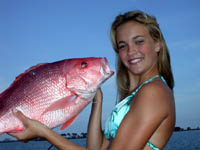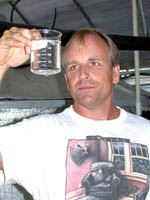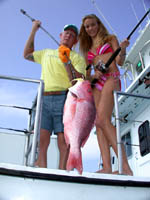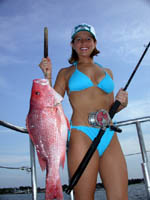
|
Features
|
|
|
|
Books
|
|
|
|
Fun & Games
|
|
|
|
Contact Us
|
|
|
John's Journal... Entry 232, Day 3
SNAPPER BONANZA
Two Ways To Spawn Snapper: Artificially and By Creating Habitat
 Editor's
Note: David Maus is a research sssociate who was brought in by the Marine
Resources Division of Alabama's Department of Conservation to design and
build the brood stock systems to hold and breed red snapper in an artificial
environment. He has masters degree in aquaculture and 20 years experience
in commercial production of marine fish, primarily red drum, black drum
and spotted seatrout. He's built and run a farm that produces and raises
over 1 million red drum fingerlings per year and produces 300,000 or 400,000
pounds of marketable size fish per year.
Editor's
Note: David Maus is a research sssociate who was brought in by the Marine
Resources Division of Alabama's Department of Conservation to design and
build the brood stock systems to hold and breed red snapper in an artificial
environment. He has masters degree in aquaculture and 20 years experience
in commercial production of marine fish, primarily red drum, black drum
and spotted seatrout. He's built and run a farm that produces and raises
over 1 million red drum fingerlings per year and produces 300,000 or 400,000
pounds of marketable size fish per year.
 In
the past, to get brood stock, Alabama's Marine Resources Division (AMRD)
has caught wild snapper, brought them into the laboratory and artificially
spawned them by giving them hormonal injections. "One of the problems
with artificially inducing the spawn," Vernon Minton, the director of
the Marine Resources Division for Alabama's Department of Conservation,
mentions, "is that we have a very-narrow window to catch the snapper and
get them to spawn. May and June are our best months, and sometimes July.
During these two primary months, the size of our facility only allows
for four or five spawns. We catch the fish, induce them to spawn and then
begin to work with the spawned eggs, a process that takes about 10 days.
So we haven't been able to get the number of fish we need and produce
the number of eggs and small snapper that we need for major restocking
effort."
In
the past, to get brood stock, Alabama's Marine Resources Division (AMRD)
has caught wild snapper, brought them into the laboratory and artificially
spawned them by giving them hormonal injections. "One of the problems
with artificially inducing the spawn," Vernon Minton, the director of
the Marine Resources Division for Alabama's Department of Conservation,
mentions, "is that we have a very-narrow window to catch the snapper and
get them to spawn. May and June are our best months, and sometimes July.
During these two primary months, the size of our facility only allows
for four or five spawns. We catch the fish, induce them to spawn and then
begin to work with the spawned eggs, a process that takes about 10 days.
So we haven't been able to get the number of fish we need and produce
the number of eggs and small snapper that we need for major restocking
effort."
 To
solve this problem, a group of fisheries scientists from Auburn University,
headed by Dr. Ron Phelps and including David Maus came to the Mariculture
Center and developed artificial habitat for the snapper. As Maus explains,
"To build an artificial habitat to cause the red snapper to spawn every
six months instead of every year, you have to be able to control the photo
periods, the temperature and the water quality, because if you don't have
good water quality, you stress the fish. If you can keep fish from being
stressed, they'll have more energy to put into growth and reproduction.
The artificial habitats are 6-feet deep with dish-shaped bottoms and have
12-foot diameters. The tank has a water-circulation pump and a bio-filtration
system. It also has a heat pump for temperature control. The lighting
system inside the habitat simulates sunrise and sunset as well as the
phases of the moon. Each tank is separate from the other and has a hood
over it to keep out light. In these artificial habitats, scientists can
control the fish's year and cause the snapper to spawn when the scientists
want them to spawn. The big advantage to the artificial habitat form of
spawning, as opposed to chemically-induced spawning, is the artificial
habitat spawn is more natural. The eggs spawned and fertilized at that
time have a much-higher survival rate than the eggs spawned using chemical
inducements." Because the researchers control all the natural conditions
in the artificial habitats, the snapper think it's time to spawn. By keeping
male and female snapper in the artificial habitat, when the females produce
eggs and prepare to spawn, the males have sperm also ready to fertilize
the eggs.
To
solve this problem, a group of fisheries scientists from Auburn University,
headed by Dr. Ron Phelps and including David Maus came to the Mariculture
Center and developed artificial habitat for the snapper. As Maus explains,
"To build an artificial habitat to cause the red snapper to spawn every
six months instead of every year, you have to be able to control the photo
periods, the temperature and the water quality, because if you don't have
good water quality, you stress the fish. If you can keep fish from being
stressed, they'll have more energy to put into growth and reproduction.
The artificial habitats are 6-feet deep with dish-shaped bottoms and have
12-foot diameters. The tank has a water-circulation pump and a bio-filtration
system. It also has a heat pump for temperature control. The lighting
system inside the habitat simulates sunrise and sunset as well as the
phases of the moon. Each tank is separate from the other and has a hood
over it to keep out light. In these artificial habitats, scientists can
control the fish's year and cause the snapper to spawn when the scientists
want them to spawn. The big advantage to the artificial habitat form of
spawning, as opposed to chemically-induced spawning, is the artificial
habitat spawn is more natural. The eggs spawned and fertilized at that
time have a much-higher survival rate than the eggs spawned using chemical
inducements." Because the researchers control all the natural conditions
in the artificial habitats, the snapper think it's time to spawn. By keeping
male and female snapper in the artificial habitat, when the females produce
eggs and prepare to spawn, the males have sperm also ready to fertilize
the eggs.
 "One
of the problems that AMRD has encountered is that not all snapper are
compatible or have the same personalities," Minton explains. "Scientists
have to make sure that the group's dynamic in the artificial habitat is
conducive to a successful spawn. Usually if a snapper in the 1000-gallon
tank doesn't get along with the other snapper, we remove the bad snapper."
Maus, with his extensive background with commercial fish hatcheries, is
trained to observe fish behavior and make sure that all the fish in the
tank like each other. Maus says that he can tell which snapper are happy
and has learned, "happy snapper are much more likely to get off a successful
spawn than unhappy snapper."
"One
of the problems that AMRD has encountered is that not all snapper are
compatible or have the same personalities," Minton explains. "Scientists
have to make sure that the group's dynamic in the artificial habitat is
conducive to a successful spawn. Usually if a snapper in the 1000-gallon
tank doesn't get along with the other snapper, we remove the bad snapper."
Maus, with his extensive background with commercial fish hatcheries, is
trained to observe fish behavior and make sure that all the fish in the
tank like each other. Maus says that he can tell which snapper are happy
and has learned, "happy snapper are much more likely to get off a successful
spawn than unhappy snapper."
To learn more about this program at the Marine Resources Division, e-mail Minton at rvminton@gulftel.com, and you also can visit www.dcnr.state.al.us/mr/cpmc.htm on the Web.
TOMORROW: THE FUTURE OF RED SNAPPER
Check back each day this week for more about SNAPPER BONANZA ...
Day 1 - The Future Has Arrived
Day 2 - The Problem With Raising Captive
Red Snapper: Producing Food For the Fry
Day 3 - Two Ways To Spawn Snapper: Artificially
and By Creating Habitat
Day 4 - The Future of Red Snapper
Day 5 - Snapper As An Aquaculture Fish